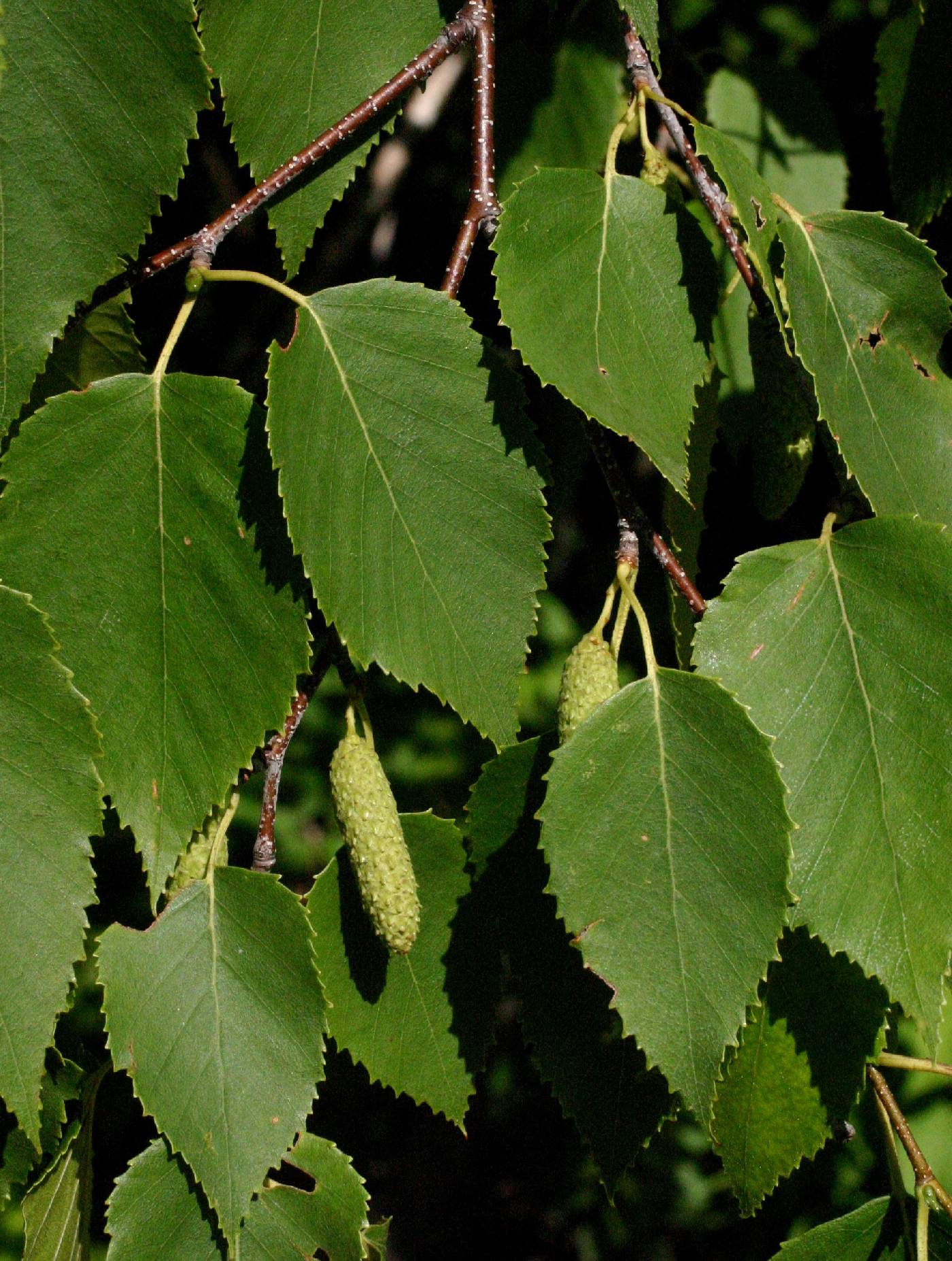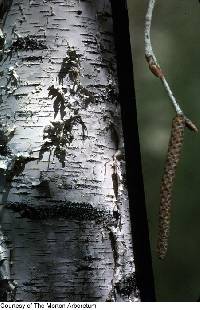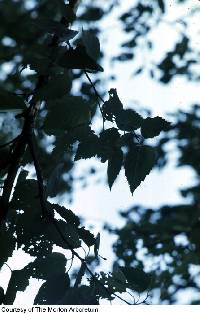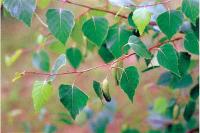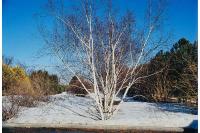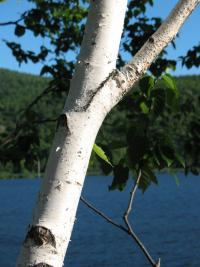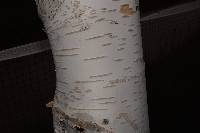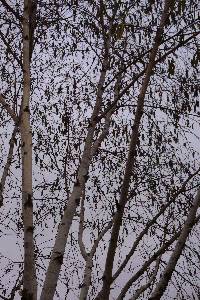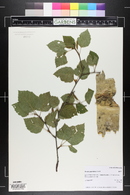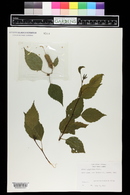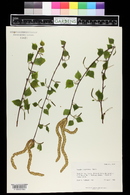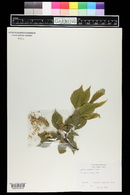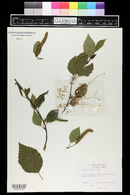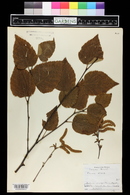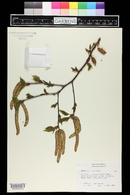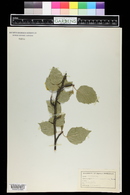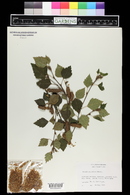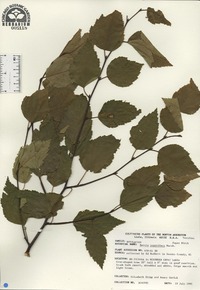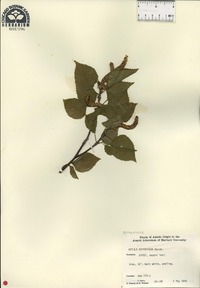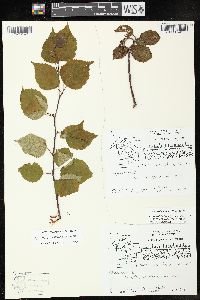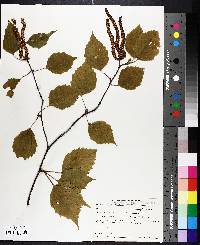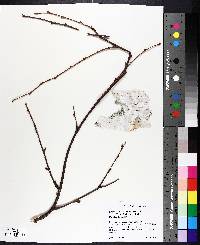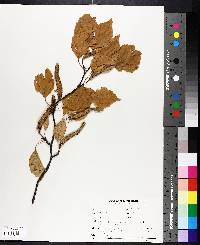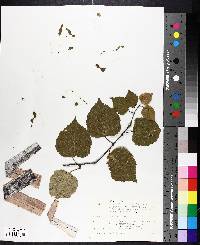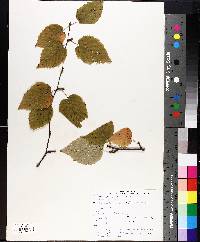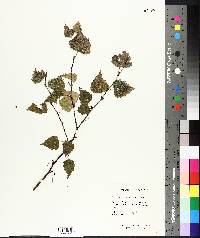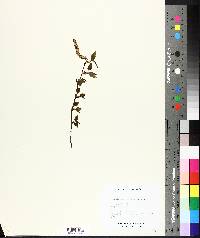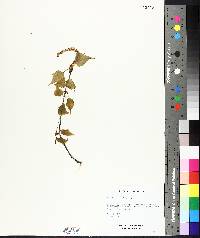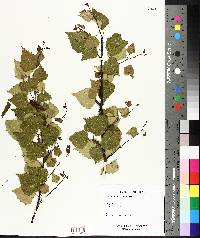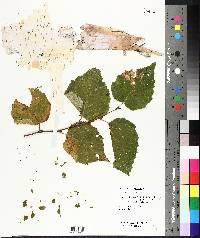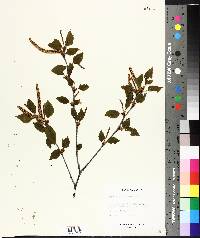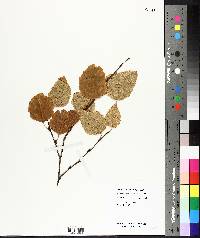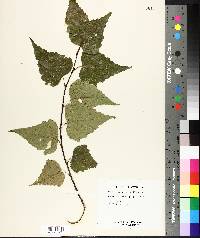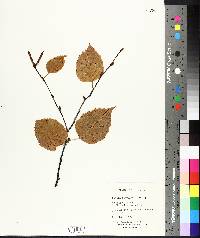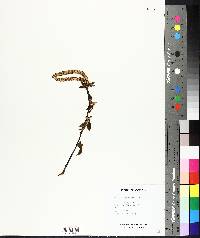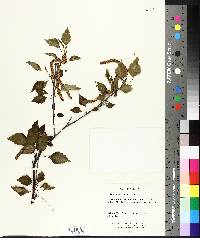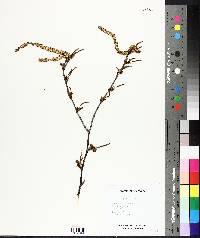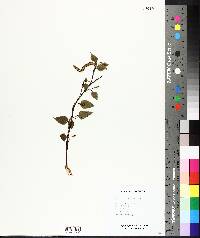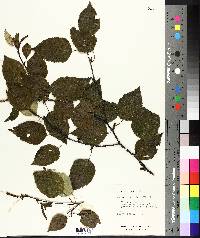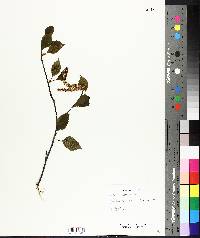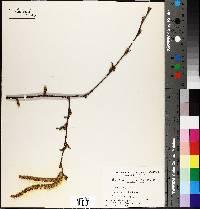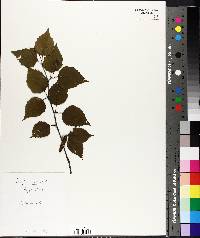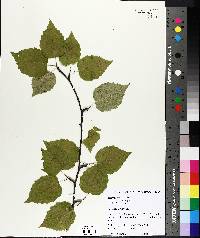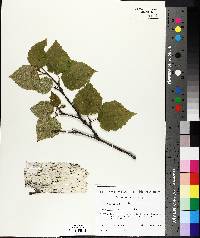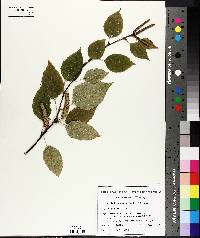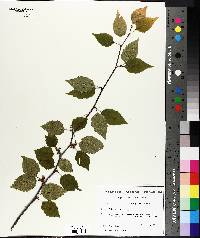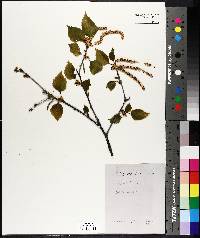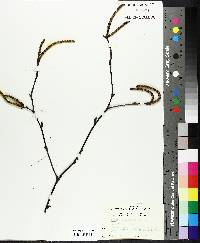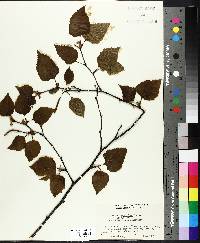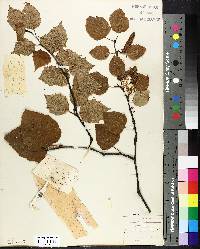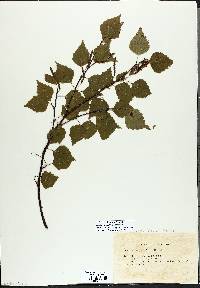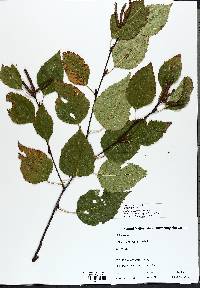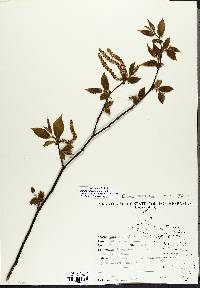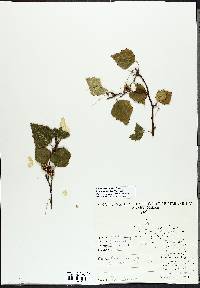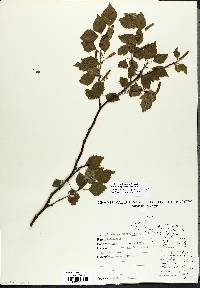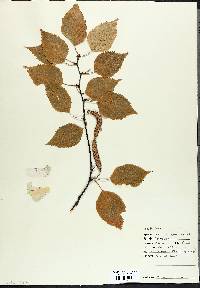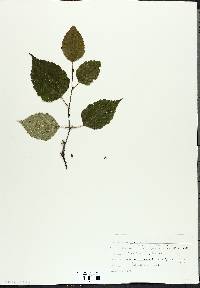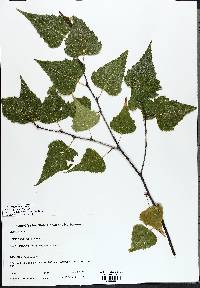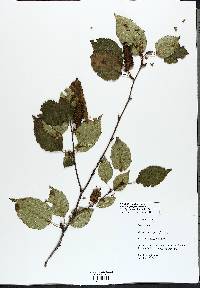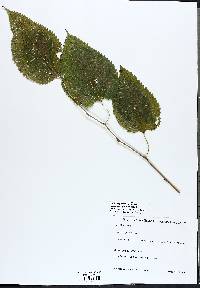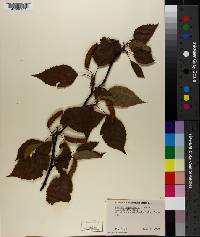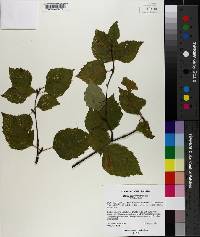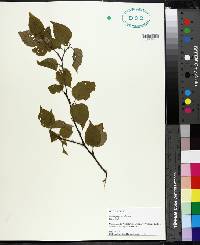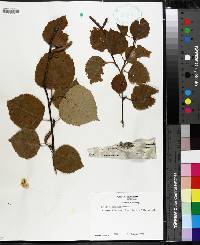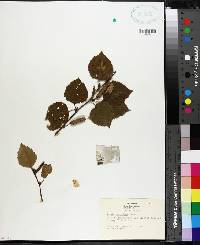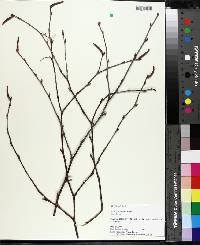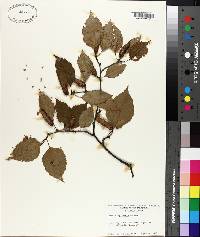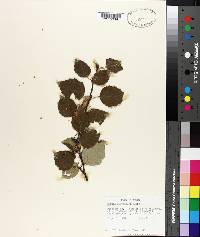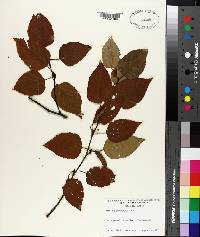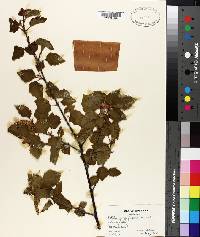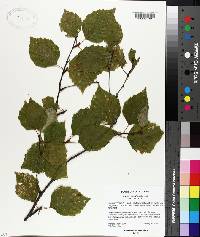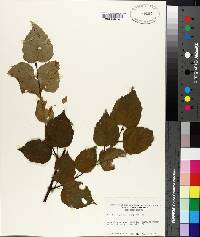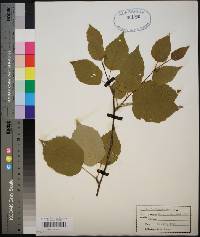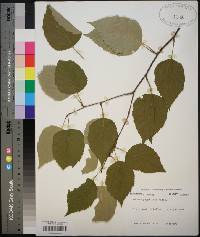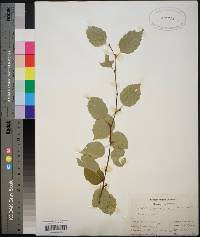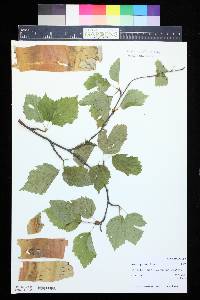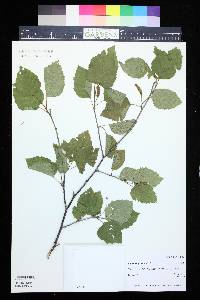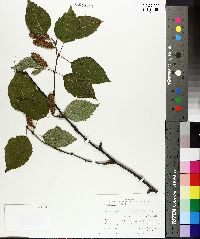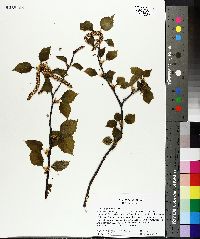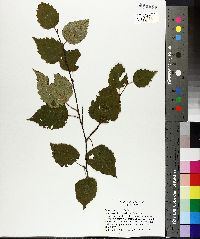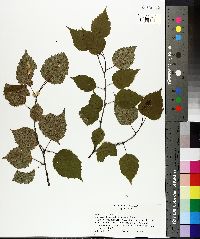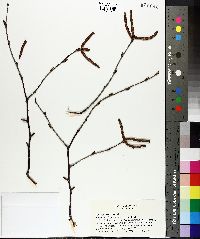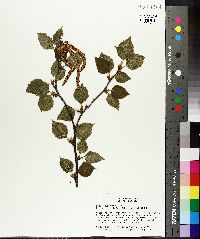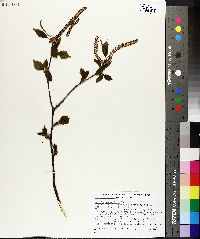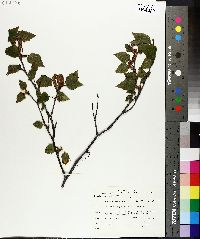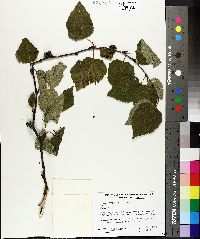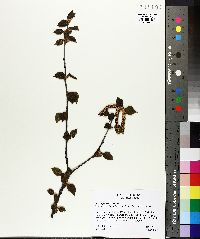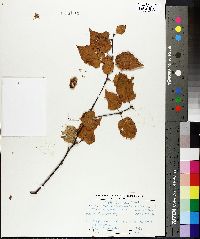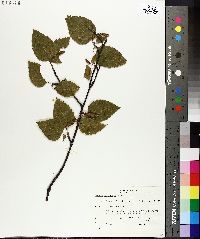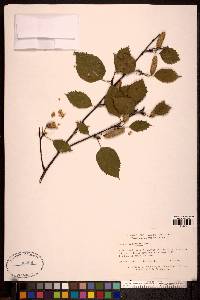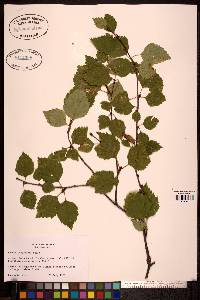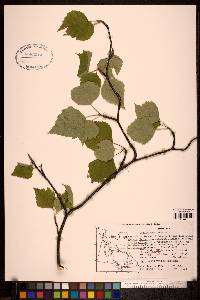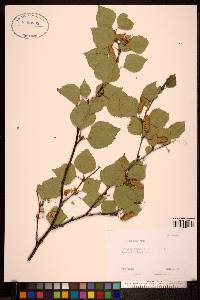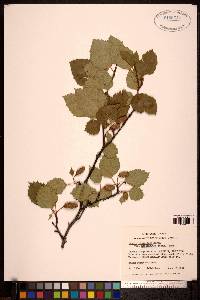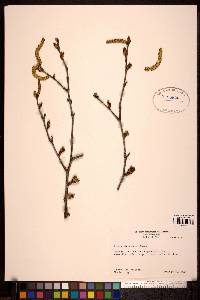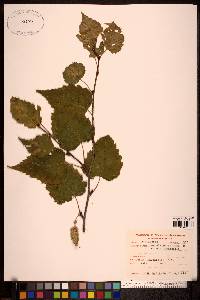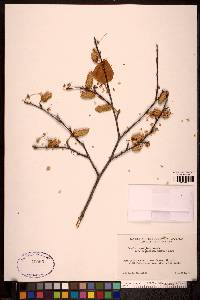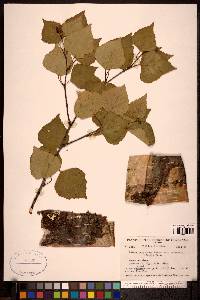Betula papyrifera
|
|
|
|
Family: Betulaceae
Paper Birch, more...canoe birch, white birch
[Betula alba var. papyrifera, moreBetula excelsa , Betula montanensis , Betula papyracea , Betula papyrifera f. coriacea Fernald & Wiegand, Betula papyrifera f. longipes Fernald, Betula papyrifera var. communis Regel ex Schelle, Betula papyrifera var. recessa Lepage, Betula subcordata] |
Trees , to 30 m, usually 20 m or shorter; trunks often single, sometimes 2 or more, mature crowns narrowly round. Bark of young trunks and branches dark reddish brown, smooth, in maturity creamy to chalky white or pale to (infrequently) dark brown, readily exfoliating in paper-thin sheets; lenticels pale, horizontal, in maturity dark, much expanded, horizontal. Twigs without strong odor and taste of wintergreen, slightly to moderately pubescent, infrequently with scattered, small, resinous glands. Leaf blade ovate with 9 or fewer pairs of lateral veins, 5--9(--12) × 4--7 cm, base rounded, cuneate, or truncate, margins sharply to coarsely or irregularly doubly serrate or serrate-dentate, apex acute to short-acuminate; surfaces abaxially sparsely to moderately pubescent, often velutinous along major veins and in vein axils, covered with minute, resinous glands. Infructescences pendulous, cylindric, 2.5--5 × 0.6--1.2 cm, readily shattering with fruits in late fall; scales pubescent to glabrous, lobes diverging at or proximal to middle, central lobe narrowly elongate, obtuse, lateral lobes about equal in length to central lobe but several times broader, strongly divergent, held nearly at right angles to axis. Samaras with wings as broad as or slightly broader than body, extended nearly beyond body apically. 2 n = 56, 70, 84. Flowering late spring. Moist, ± open, upland forest, especially on rocky slopes, also sometimes in swampy woods; 300--900 m; St. Pierre and Miquelon; Alta., B.C., Man., N.B., Nfld., N.W.T., N.S., Ont., P.E.I., Que., Sask., Yukon; Alaska, Colo., Conn., Idaho, Ill., Ind., Iowa, Maine, Mass., Mich., Minn., Mont., Nebr., N.H., N.J., N.Y., N.Dak., Oreg., Pa., R.I., S.Dak., Vt., Va., Wash., Wis., Wyo. Betula papyrifera is a well-known tree of the northern forest with its paper-thin, white, peeling bark. The bark, which has a high oil content and is consequently waterproof, was used for a wide variety of building and clothing purposes by the American Indians, including the covering of the familiar birch bark canoe. It is still used for various purposes, including basketmaking, in Canada and Alaska. Variants having more or less close, dark brown bark ( B . papyrifera var. commutata ) occur locally throughout the wide range of this species; this characteristic appears to be largely environmentally caused. The species is an important successional tree, coming up readily after fires, logging, or the abandonment of cultivated land. The relatively soft, whitish wood is used extensively for such items as clothespins, spools, ice cream sticks, and toothpicks, as well as for pulpwood for paper. Betula papyrifera is the state tree of New Hampshire. Native Americans use Betula papyrifera medicinally in enemas, to shrivel the womb, to alleviate stomach cramps and pain, and as a tonic (D. E. Moerman 1986). Betula × sandbergii Britton is a fairly common hybrid, occurring where the ranges of the parents ( B . papyrifera Marshall and B . pumila Linnaeus) come into contact. In most vegetative features it is intermediate between the parental conditions (K. E. Clausen 1963; C. O. Rosendahl 1928).
Tree 15 - 22 m tall, trunk 30 cm - 0.6 m in diameter Leaves: alternate, solitary on long shoots, in groups of three on spur shoots, stalked, dark green above, lighter beneath, 5 - 8 cm long, 3 - 5 cm wide, egg-shaped to nearly triangular, coarsely toothed except near base, early leaves becoming smooth, late leaves retaining hairs (sometimes only in leaf axils), with three to nine pairs of veins. Fall color is brilliant yellow. Flowers: either male or female, found on the same tree (monoecious), borne in catkins. Male catkins are brown, 7 - 10 cm long, and hang in pairs or small clusters. Female catkins green, 3 - 4 cm long, erect. Fruit: a seed with wide wings on each side (samara), borne in stalked, drooping catkins 3 - 4 cm long, scales shaped like a cross and hairy along the margin, catkins falling apart when ripe. Bark: dark reddish brown when young, changing to creamy white with long corky horizontal lines (lenticels) on trunk and large branches, exfoliating in thin paper-like sheets to reveal orange inner bark, becoming furrowed and dark at the base. Twigs: slender, changing from dull red to shiny orangish brown. Short spur shoots develop on older growth. Terminal buds: absent. Form: changing from loosely pyramidal to irregularly rounded or oval, single- or multi-trunked. End and lateral buds: 5 - 7 mm long, narrow egg-shaped with a short-pointed tip, slightly flattened, scales green on lower half and changing to brown and hairy near margin. Similar species: Three white-barked birches grow in the Chicago Region: Betula papyrifera, Betula pendula, and Betula populifolia. Betula populifolia has bark that does not exfoliate and develops black triangles below the branches, leaves that are widest at the base with a long-pointed tip, and male catkins that are usually borne singly. Betula pendula has bark that rarely exfoliates but develops diamond-shaped black fissures, especially near the base, leaves that are widest at the base with a long pointed tip, and male catkins that are usually borne in pairs. Flowering: mid April to mid May Habitat and ecology: Most Chicago Region specimens are found in the counties surrounding Lake Michigan, because the climate and soil combination found there is desireable for this species. It grows on clay ravine slopes on Lake Michigan bluffs, cool wooded ravines, and wooded swamps. Betula papyrifera germinates better after a fire as the seeds are exposed to mineral soil. Fire also stimulates multiple sprouts from damaged trees. Occurence in the Chicago region: native Notes: The wood is used for pulpwood, veneer, burning in fireplaces, bobbins, handles, spools, and dowels. Native Americans used to make canoes, wigwam coverings and utensils with the bark. This species makes a better landscape tree than B. pendula in the Chicago Region. Etymology: Betula is the Latin name for birch. Papyrifera comes from the Latin words for paper-bearing, referring to the bark. Author: The Morton Arboretum Usually a small to middle-sized tree, occasionally to 30 m, often slightly leaning rather than strictly erect; bark white or nearly so, with horizontal (often semilunate) black marks about the branches, easily separable into thin layers, the peeled plates showing salmon-pink on the inside; lvs ovate, 5-10 cm, acuminate, sharply serrate or doubly serrate, cuneate to rounded at base, glabrous above, very sparsely pubescent beneath, usually only along the veins or in the vein-axils; fruiting catkins 3-5 cm; scales 3.9-6.2 mm, two-thirds to fully as wide, the lateral lobes broadly falcate-obovate, divergent, the middle lobe tapering; frs oblate, deeply retuse, broadly winged, 1.8-3.4 n2.7-5 mm, the body 0.9-1.5 mm wide; mostly polyploid, often 2n=70. Seral in moist or dry soil after fire or other disturbance; Lab. to Alas., s. to N.J., W.Va., n. Ind., and ne. Io. Becoming very dwarf at and above timberline in the White Mts. of N.H. and perhaps elsewhere. Most of our plants are var. papyrifera, as described above. The well marked but wholly confluent var. cordifolia is separately described. Gleason, Henry A. & Cronquist, Arthur J. 1991. Manual of vascular plants of northeastern United States and adjacent Canada. lxxv + 910 pp. ©The New York Botanical Garden. All rights reserved. Used by permission. From Flora of Indiana (1940) by Charles C. Deam This is a far northern species and is found in Indiana only in the counties shown on the map. There are a few small colonies of it and it grows in rather moist, sandy soil. ...... Indiana Coefficient of Conservatism: C = 7 Wetland Indicator Status: FACU |

